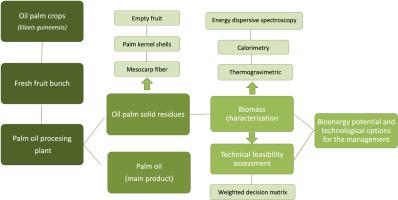Biomass & Bioenergy ( IF 5.8 ) Pub Date : 2020-09-23 , DOI: 10.1016/j.biombioe.2020.105668 E.J. Ordoñez-Frías , J.A. Azamar-Barrios , E. Mata-Zayas , O. Silván-Hernández , L. Pampillón-González

|
Bioenergy around the world has proved to be a feasible strategy in terms of environmental, social and economic advantages for the development of our society. Nevertheless, in low- and middle-income countries, wood is the most traditional common biomass resource. At the same time, there is a wide variety of residues from industry processing that can be valorized. In recent years, oil palm production in Mexico has increased significantly; giving rise to the establishment of extraction plants whose process focuses mostly on oil extraction, disregarding solid by-products. The lack of proper management of these residues impacts the environment by piling up without control, open burning or left on the ground. For these reasons, this study aimed to assess the bioenergy potential and identify the most feasible technologies for the sustainable use of oil palm residues. Oil palm residues (fruit fiber, palm kernel shells and empty fruit bunches) were characterized by proximate analysis, calorific value and energy dispersive spectroscopy. A weighted decision matrix was designed to weigh the biomass conversion technologies considering sustainability criteria (environmental, technical, economic and social). As a result, a biomass and energy potential of 33,416 t y−1 and 564.05 TJ y−1 were calculated for Tabasco palm oil sector. Pelletization of residue for thermal applications, followed by anaerobic digestion turned out to be the most feasible technologies for oil palm residue according to the regional context. An opportunity for pellet production from these residues was observed; this could be an alternative to substitute fuel wood and promotes modern bioenergy applications.
中文翻译:

油棕加工残留物的生物能源潜力和技术可行性评估:以墨西哥塔巴斯科州Jalapa为例
就环境,社会和经济优势而言,全世界的生物能源已被证明是可行的战略,对我们的社会发展至关重要。然而,在中低收入国家,木材是最传统的常见生物质资源。同时,来自工业加工的各种残留物可以被评估。近年来,墨西哥的油棕产量大幅度增加;导致建立了提取工厂,其过程主要集中在石油提取上,而无视固体副产物。缺乏对这些残留物的适当管理,会无控制地堆积,露天焚烧或留在地面上,从而影响环境。由于这些原因,这项研究旨在评估生物能源的潜力,并确定可持续利用油棕残留物的最可行技术。通过近距离分析,热值和能谱分析对油棕残留物(水果纤维,棕榈仁壳和空果串)进行了表征。设计了加权决策矩阵来权衡考虑可持续性标准(环境,技术,经济和社会)的生物质转化技术。结果,生物量和能量潜力为33,416 t y 技术,经济和社会)。结果,生物量和能量潜力为33,416 t y 技术,经济和社会)。结果,生物量和能量潜力为33,416 t y计算了塔巴斯科州棕榈油部门的-1和564.05 TJ y -1。根据区域情况,将残渣制粒用于热应用,然后进行厌氧消化是油棕残渣最可行的技术。观察到由这些残留物产生颗粒的机会。这可以替代燃木并促进现代生物能源的应用。











































 京公网安备 11010802027423号
京公网安备 11010802027423号